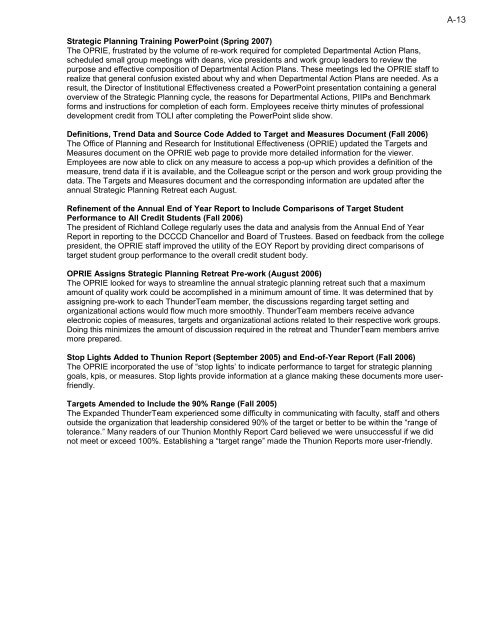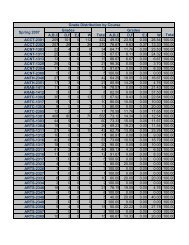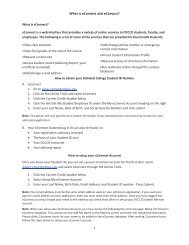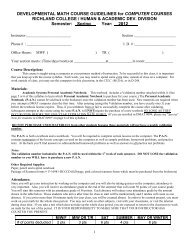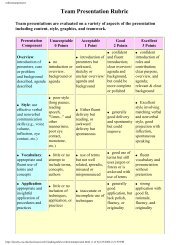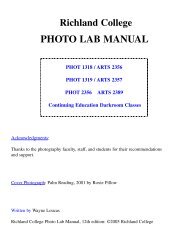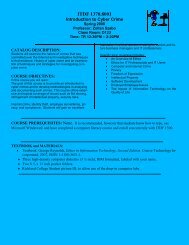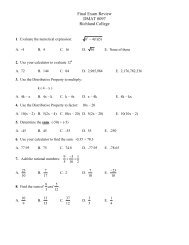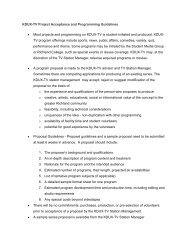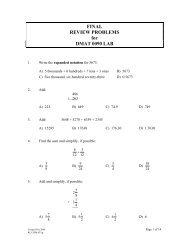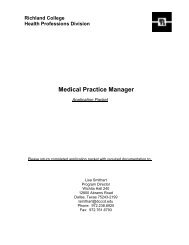End of Year Report - Richland College
End of Year Report - Richland College
End of Year Report - Richland College
Create successful ePaper yourself
Turn your PDF publications into a flip-book with our unique Google optimized e-Paper software.
A-13<br />
Strategic Planning Training PowerPoint (Spring 2007)<br />
The OPRIE, frustrated by the volume <strong>of</strong> re-work required for completed Departmental Action Plans,<br />
scheduled small group meetings with deans, vice presidents and work group leaders to review the<br />
purpose and effective composition <strong>of</strong> Departmental Action Plans. These meetings led the OPRIE staff to<br />
realize that general confusion existed about why and when Departmental Action Plans are needed. As a<br />
result, the Director <strong>of</strong> Institutional Effectiveness created a PowerPoint presentation containing a general<br />
overview <strong>of</strong> the Strategic Planning cycle, the reasons for Departmental Actions, PIIPs and Benchmark<br />
forms and instructions for completion <strong>of</strong> each form. Employees receive thirty minutes <strong>of</strong> pr<strong>of</strong>essional<br />
development credit from TOLI after completing the PowerPoint slide show.<br />
Definitions, Trend Data and Source Code Added to Target and Measures Document (Fall 2006)<br />
The Office <strong>of</strong> Planning and Research for Institutional Effectiveness (OPRIE) updated the Targets and<br />
Measures document on the OPRIE web page to provide more detailed information for the viewer.<br />
Employees are now able to click on any measure to access a pop-up which provides a definition <strong>of</strong> the<br />
measure, trend data if it is available, and the Colleague script or the person and work group providing the<br />
data. The Targets and Measures document and the corresponding information are updated after the<br />
annual Strategic Planning Retreat each August.<br />
Refinement <strong>of</strong> the Annual <strong>End</strong> <strong>of</strong> <strong>Year</strong> <strong>Report</strong> to Include Comparisons <strong>of</strong> Target Student<br />
Performance to All Credit Students (Fall 2006)<br />
The president <strong>of</strong> <strong>Richland</strong> <strong>College</strong> regularly uses the data and analysis from the Annual <strong>End</strong> <strong>of</strong> <strong>Year</strong><br />
<strong>Report</strong> in reporting to the DCCCD Chancellor and Board <strong>of</strong> Trustees. Based on feedback from the college<br />
president, the OPRIE staff improved the utility <strong>of</strong> the EOY <strong>Report</strong> by providing direct comparisons <strong>of</strong><br />
target student group performance to the overall credit student body.<br />
OPRIE Assigns Strategic Planning Retreat Pre-work (August 2006)<br />
The OPRIE looked for ways to streamline the annual strategic planning retreat such that a maximum<br />
amount <strong>of</strong> quality work could be accomplished in a minimum amount <strong>of</strong> time. It was determined that by<br />
assigning pre-work to each ThunderTeam member, the discussions regarding target setting and<br />
organizational actions would flow much more smoothly. ThunderTeam members receive advance<br />
electronic copies <strong>of</strong> measures, targets and organizational actions related to their respective work groups.<br />
Doing this minimizes the amount <strong>of</strong> discussion required in the retreat and ThunderTeam members arrive<br />
more prepared.<br />
Stop Lights Added to Thunion <strong>Report</strong> (September 2005) and <strong>End</strong>-<strong>of</strong>-<strong>Year</strong> <strong>Report</strong> (Fall 2006)<br />
The OPRIE incorporated the use <strong>of</strong> “stop lights’ to indicate performance to target for strategic planning<br />
goals, kpis, or measures. Stop lights provide information at a glance making these documents more userfriendly.<br />
Targets Amended to Include the 90% Range (Fall 2005)<br />
The Expanded ThunderTeam experienced some difficulty in communicating with faculty, staff and others<br />
outside the organization that leadership considered 90% <strong>of</strong> the target or better to be within the “range <strong>of</strong><br />
tolerance.” Many readers <strong>of</strong> our Thunion Monthly <strong>Report</strong> Card believed we were unsuccessful if we did<br />
not meet or exceed 100%. Establishing a “target range” made the Thunion <strong>Report</strong>s more user-friendly.


